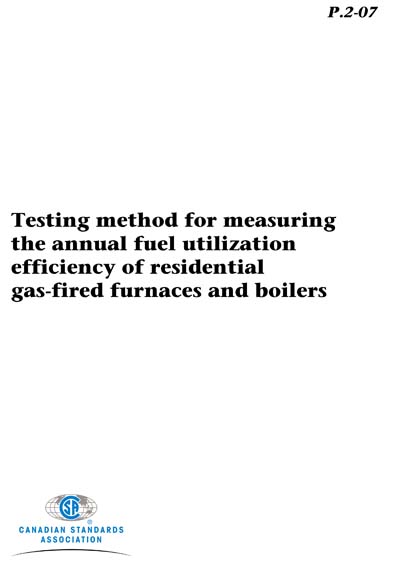Historical
CAN/CSA P.2-2007
CAN/CSA-P.2-07 - Testing Method for Measuring the Annual Fuel Utilization Efficiency of Residential Gas-Fired Furnaces and Boilers
Update #1 was published as notification that this is now a National Standard of Canada.
Preface
This is the second edition of CSA P.2, Testing method for measuring the annual fuel utilization efficiency of residential gas-fired furnaces and boilers. It supersedes the previous edition, published in 1991 by the Canadian Gas Association (CGA) under the title Testing Method for Measuring Annual Fuel Utilization Efficiencies of Residential Furnaces and Boilers.1. Scope
1.1 This Standard specifies a testing method for measuring the annual fuel utilization efficiency (AFUE) of residential gas-fired forced-air furnaces and low-pressure steam and hot water boilers and includes (a) a testing method for cyclic and part-load performance; (b) methods for interpolating and extrapolating test data; and (c) calculation procedures for establishing seasonal performance.1.2 This Standard applies to furnaces with inputs less than 65.9 kW (225 000 Btu/h) and boilers with inputs less than 88 kW (300 000 Btu/h) intended for use in residential applications. This Standard also applies to packaged furnaces with inputs less than 65.9 kW (225 000 Btu/h) that contain an air conditioner within the same cabinet that has a rated cooling capacity of 19 kW (65 000 Btu/h) or less.
1.3 Furnace and boiler classifications covered by this Standard are listed in Table 1.
1.4 This Standard does not fully take into account the effects of heating system installation variables and therefore cannot be used to determine absolute measures of performance for specific installation configurations. Accordingly, this Standard is intended to be used for comparing energy consumption measurements of furnace and boiler models.
1.5 In CSA Standards, "shall" is used to express a requirement, i.e., a provision that the user is obliged to satisfy in order to comply with the standard; "should" is used to express a recommendation or that which is advised but not required; "may" is used to express an option or that which is permissible within the limits of the standard; and "can" is used to express possibility or capability. Notes accompanying clauses do not include requirements or alternative requirements; the purpose of a note accompanying a clause is to separate from the text explanatory or informative material. Notes to tables and figures are considered part of the table or figure and may be written as requirements. Annexes are designated normative (mandatory) or informative (non-mandatory) to define their application.
1.6 The values given in SI (metric) units are the standard. The values given in parentheses are for information only but are exact.
Content Provider
CSA America, Inc. [csa]






